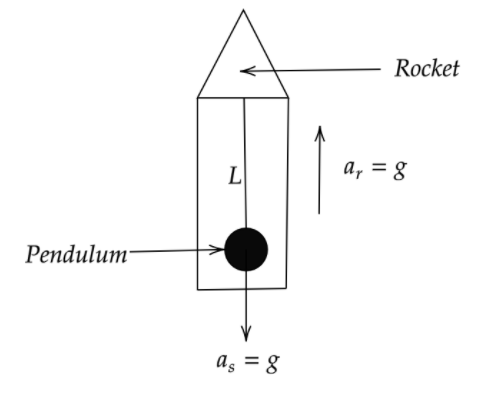
The period of oscillation of a simple pendulum of length L suspended from the roof of a rocket acceleration upwards with a constant acceleration (g) is given by?
(A) Infinity
(B) Zero
(C)
(D)
Answer
396.9k+ views
Hint: First we need to draw a free body diagram representing all the parameters required to solve this problem. Now by taking the rocket as the frame of reference we can find the effective acceleration acting on the pendulum which is acting downward. Now applying the time period formula we can find the solution to this problem.
Complete step by step answer:
As per the problem we know that a simple pendulum of length L suspended from the roof of a rocket accelerates upwards with a constant acceleration (g).
Now we need to find the time period of the simple pendulum.

Here in this problem the rocket accelerates with a constant acceleration of g in the upward direction. From the figure we can say that a rocket is an acceleration frame of reference. As we know that Newton's law is not applicable in the acceleration frame of reference hence if we want to use Newton's law of motion in the acceleration frame of reference then we have to use a pseudo acceleration that is acting on the pendulum.
Since the rocket is accelerating in an upward direction same as that of the acceleration due to gravity and the pendulum bob experiences downward pseudo acceleration which is also equal to g.
Therefore the effective acceleration acting on the pendulum is equals to,
Where,
And
Now putting the respective values we will get,
We know the periodic time of a simple pendulum as,
Therefore the correct option is (C).
Note: Remember that here the pseudo force acting on the pendulum is opposite to the direction of acceleration of the frame of reference and the pseudo force or acceleration is always equal to the magnitude of the reference acceleration or force. Note that pseudo force or acceleration is an apparent force that acts on all the masses whose motion is described using a non-inertial frame of reference.
Complete step by step answer:
As per the problem we know that a simple pendulum of length L suspended from the roof of a rocket accelerates upwards with a constant acceleration (g).
Now we need to find the time period of the simple pendulum.

Here in this problem the rocket accelerates with a constant acceleration of g in the upward direction. From the figure we can say that a rocket is an acceleration frame of reference. As we know that Newton's law is not applicable in the acceleration frame of reference hence if we want to use Newton's law of motion in the acceleration frame of reference then we have to use a pseudo acceleration that is acting on the pendulum.
Since the rocket is accelerating in an upward direction same as that of the acceleration due to gravity and the pendulum bob experiences downward pseudo acceleration which is also equal to g.
Therefore the effective acceleration acting on the pendulum is equals to,
Where,
And
Now putting the respective values we will get,
We know the periodic time of a simple pendulum as,
Therefore the correct option is (C).
Note: Remember that here the pseudo force acting on the pendulum is opposite to the direction of acceleration of the frame of reference and the pseudo force or acceleration is always equal to the magnitude of the reference acceleration or force. Note that pseudo force or acceleration is an apparent force that acts on all the masses whose motion is described using a non-inertial frame of reference.
Latest Vedantu courses for you
Grade 10 | MAHARASHTRABOARD | SCHOOL | English
Vedantu 10 Maharashtra Pro Lite (2025-26)
School Full course for MAHARASHTRABOARD students
₹31,500 per year
Recently Updated Pages
Master Class 11 Economics: Engaging Questions & Answers for Success

Master Class 11 Business Studies: Engaging Questions & Answers for Success

Master Class 11 Accountancy: Engaging Questions & Answers for Success

Master Class 11 English: Engaging Questions & Answers for Success

Master Class 11 Computer Science: Engaging Questions & Answers for Success

Master Class 11 Maths: Engaging Questions & Answers for Success

Trending doubts
State and prove Bernoullis theorem class 11 physics CBSE

What are Quantum numbers Explain the quantum number class 11 chemistry CBSE

Write the differences between monocot plants and dicot class 11 biology CBSE

Why is steel more elastic than rubber class 11 physics CBSE

Explain why a There is no atmosphere on the moon b class 11 physics CBSE

1 ton equals to A 100 kg B 1000 kg C 10 kg D 10000 class 11 physics CBSE




